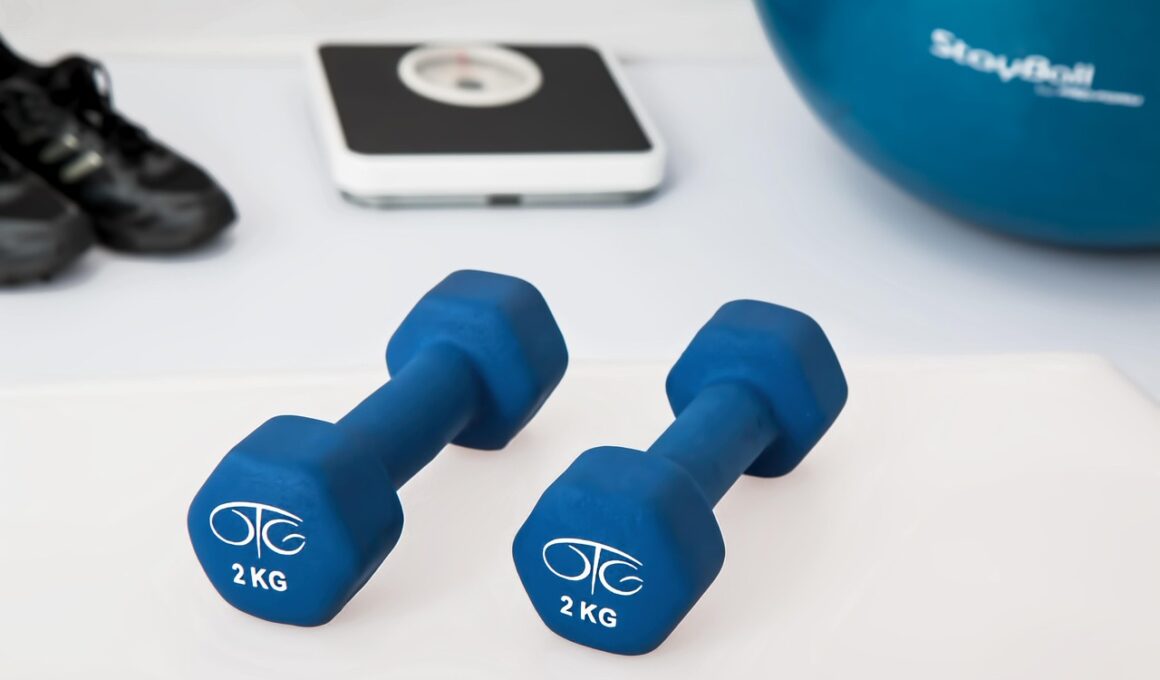Improving Posture Through Shoulder Conditioning Exercises
Posture plays a vital role in overall health and wellness. Poor posture can lead to various physical issues, including back pain, neck strain, and reduced mobility. Therefore, incorporating shoulder conditioning exercises can significantly improve posture. These exercises aim to strengthen the muscles around the shoulder and upper back, promoting better alignment and stability. A strong shoulder girdle supports the neck and spine, reducing the risk of injuries. Furthermore, good posture contributes to enhanced self-confidence and appearance. Many individuals struggle with slumped shoulders or forward head posture due to extended periods of desk work or poor habits. To combat this, specific exercises designed to focus on shoulder mobility and strength should be performed consistently. Essential shoulder exercises include wall angels, external rotations, and shoulder blades squeezes. These strengthen key muscle groups, including the rotator cuff and scapular stabilizers. By integrating these exercises into a regular fitness routine, individuals can progressively enhance their posture. A simplified approach to these exercises makes them accessible to everyone, regardless of fitness level. Consistency and patience are important to achieve desired results.
Benefits of Shoulder Conditioning
The benefits of shoulder conditioning extend beyond posture improvement. Enhanced shoulder strength also leads to better performance in a variety of activities, whether at work or during sports. A stable shoulder complex allows for improved functionality in upper body movements, reducing fatigue and preventing injuries over time. Moreover, strong shoulders help maintain a balanced physique, which is crucial for overall stability and functionality. Improved posture can alleviate many common issues; for example, tension headaches often result from neck strain caused by postural habits. Exercises such as resistance band pulls, shoulder presses, and rotator cuff exercises can be beneficial. They target muscle groups that contribute to shoulder stability and alignment. Additionally, these exercises can even translate to direct improvements in athletic performance, especially in sports demanding significant upper body engagement. Enhanced shoulder strength allows for greater endurance and reduced risk of injury during competitive activities. Regular conditioning not only reinforces proper alignment but serves as a preventive measure against future musculoskeletal disorders. In that sense, developing a conditioning routine is both a proactive and reactive strategy for improved health.
Before embarking on any shoulder conditioning program, it’s crucial to assess your current flexibility and strength levels. Knowing where you stand helps tailor your exercise regimen effectively. A professional assessment can identify muscle imbalances or restrictions that may affect posture. It can also uncover any preexisting conditions that could intensify during exercise. The ideal starting point involves learning proper techniques and gradually increasing the intensity of workouts. Emphasizing form reduces the risk of injury and maximizes the exercise’s effectiveness. Furthermore, it’s advisable to integrate stretching routines, focusing on tight muscle areas, like the chest and neck. Incorporating routine flexibility exercises can complement shoulder strengthening efforts, leading to a well-rounded approach to improving posture. Incorporate exercises dynamically; for example, engaging in bodyweight movements such as push-ups and dips can also stimulate shoulder muscles. These bodyweight exercises enhance strength and contribute to overall conditioning. When you consistently practice these moves, you’ll notice not just improvements in your posture but also in your upper body strength, endurance, and functional capacity. Remember that the ultimate goal is a well-balanced and strong upper body that supports efficient movement patterns.
Integrating Shoulder Exercises into Your Routine
Integrating shoulder conditioning exercises into your existing workout routine can be smooth and enjoyable. Start by dedicating at least two to three days weekly to focus specifically on shoulder exercises. This allows for adequate recovery, which is vital for muscle growth and strength. A balanced schedule should include strength training, flexibility, and aerobic activities, creating a well-rounded approach to fitness. You can begin sessions with dynamic warm-ups, preparing your muscles for the work ahead, enhancing injury prevention. Following warm-ups, proceed with targeted shoulder exercises focusing on quality over quantity. For instance, practice low weight and high repetitions to enhance muscle endurance without risking injury. It’s also beneficial to split shoulder workouts into push and pull days to focus on different muscle groups effectively. Include movements like face pulls and resistance band exercises for maximum impact. Keeping a detailed log of progress can motivate you by visually demonstrating improvements. Stay cautious not to overwork the shoulders, rest is as crucial as exercises themselves. Allow for growth, recovery, and adaptation as you progress on this journey to better posture through shoulder conditioning.
Nutrition plays a significant role in enhancing your shoulder conditioning regimen. A well-balanced diet can help support muscle recovery and growth, ultimately promoting better performance in exercises. Focus on consuming adequate protein, which is vital for muscle repair and building. Healthy fats and carbohydrates provide necessary fuel and energy for workouts. Additionally, hydrating properly can influence your performance during intense conditioning sessions. Dehydration can impair muscle function and recovery time. Include foods rich in vitamins and minerals that contribute to overall joint health, such as leafy greens, nuts, and fish. Omega-3 fatty acids are beneficial for reducing inflammation and supporting joint dynamics, which can enhance your conditioning efforts. Meal prepping can help ensure that you consume nutritious meals consistently, thereby supporting your fitness goals effectively. Adjust your diet according to workout intensity and personal energy requirements. As you assess your dietary habits, consider seeking guidance from a nutritionist or dietitian to address specific needs. Overall, healthy eating not only fuels the body but promotes optimal performance within a shoulder conditioning program, contributing towards achieving your desired fitness milestones.
Listening to Your Body
Listening to your body is essential when engaging in any physical training program, including shoulder conditioning. Pay attention to messages your body sends regarding fatigue or discomfort; these are signals you should heed. Engaging in appropriate warm-up routines before exercising can also prepare your muscles for the activities ahead and prevent injury. Monitor your range of motion and strength to adapt your workouts effectively based on personal progress. If an exercise causes pain rather than muscle fatigue, cease it and consult a professional for advice. It’s also essential to ensure that rest days are factored into your routine for optimal muscle recovery. Each muscle group needs time to recover to rebuild stronger and more resilient. Stretching can also be included on non-training days to improve flexibility further and enhance recovery. Always remember to complete your workout with cool-down stretches aimed at reducing muscle soreness and promoting blood circulation. By understanding your body’s limits and strengths, you can create a sustainable shoulder conditioning routine that yields lasting results. Achieving improved posture through conditioning is a gradual process, so remain patient and diligent.
In conclusion, incorporating shoulder conditioning exercises significantly improves posture and has various health benefits impacting physical well-being positively. With a focus on strength, flexibility, and endurance, individuals can experience noticeable changes in their overall posture and functionality. Committing to a well-structured conditioning routine requires dedication, consistency, and the right approach. As you progress through exercises, recognize that improvement is a journey that takes time and commitment. Alongside this journey, make sure to focus on overall wellness, which includes proper nutrition, hydration, and recovery. Stay attuned to your body, and adjust your conditioning plan as required to meet your changing needs. Engaging in shoulder conditioning exercises not only strengthens your upper body but enhances your overall functional capacity as you build better posture. Be sure to integrate exercises that target key muscle groups which contribute to better alignment as a part of your fitness routine. As you develop this habit, strive for continuous improvement and remain committed. Tracking progress can keep you motivated and accountable, ensuring exercise remains enjoyable. Improved posture through shoulder conditioning leads to a more confident and functional lifestyle.
By embracing shoulder conditioning exercises, individuals can actively contribute to a healthier and more confident life. Recognizing the importance of posture is the first critical step towards overall wellness. The concise importance of strength, flexibility, and good body mechanics serves to promote efficient movement patterns as well. Over time, working on posture through these exercises fosters respect for one’s body and a greater understanding of physical capabilities. It encourages increased physical activity, greatly benefiting not just posture, but physical and emotional health as well. Engaging in shoulder conditioning guides individuals towards lifestyle choices that embrace movement and physicality. These practices not only enhance posture but contribute to long-term health benefits. The journey towards improved posture often requires a multifaceted approach, combining various strategies alongside consistent conditioning exercises. Over time, this consistent focus translates into healthier habits that emphasize functional strength and injury prevention. Seek the help of professionals whenever necessary to maximize results effectively and to empower yourself in this journey. In essence, conditioning the shoulders is not merely about aesthetics; it’s fundamentally about overall health and functional movement, leading to a more balanced, empowered life.





